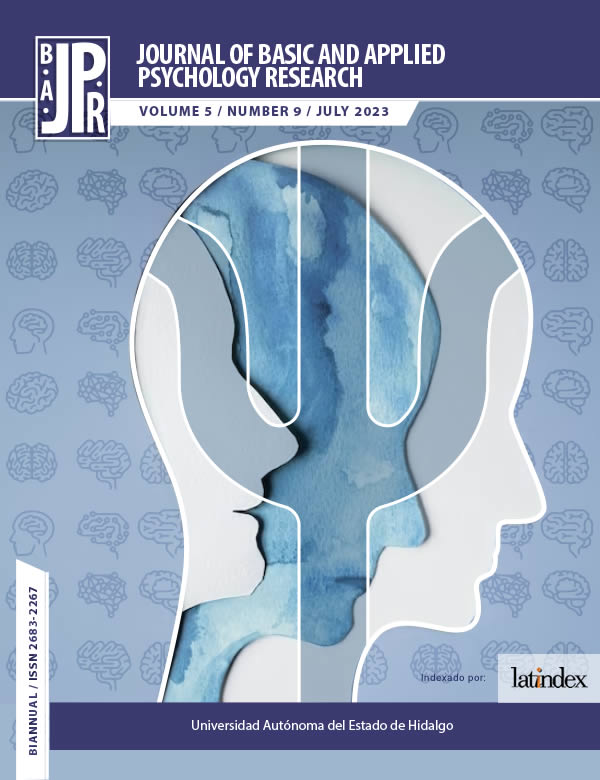Personality differences among college students according to their career and level of satisfaction
DOI:
https://doi.org/10.29057/jbapr.v5i9.9298Keywords:
Conscientiousness, neuroticism, Big Five Personality Factors, comparisonAbstract
The aim of this study was to analyze personality in college students on third and fourth year from different careers to test the hypothesis that the personality of the students is differentiable according to their career. 259 university students from Oaxaca, México were evaluated; 152 women and 105 men with an average age of 21.37 (SD = 1.92) classified into four groups; engineering, medicine, business, and psychology. The research was quantitative and descriptive, personality was evaluated through the Big Five Inventory. The ANOVA analysis was applied to search for personality differences, no significant comparisons were found to support the initial hypothesis. The information was analyzed again considering the satisfaction variable, when comparing the groups, it was found that satisfied students are more conscientious while dissatisfied students are higher in neuroticism. These differences were significant (R= 0.004** y N< 0.001***) and are consistent with studies on the level of life satisfaction in relation to personality factors.
Downloads
Publication Facts
Reviewer profiles N/A
Author statements
Indexed in
- Academic society
- N/A
- Publisher
- Universidad Autónoma del Estado de Hidalgo
References
American Psychological Association. 2017. “American Psychological Association. Ethical Principles of Psychologists and Code of Conduct.” American Psychologist 57(12):1–20.
Carmona Halty, M. A., & Rojas Paz, P. P. (2014). Rasgos de personalidad, necesidad de cognición y satisfacción vital en estudiantes universitarios chilenos. Universitas Psychologica, 13(1), 83–93. https://doi.org/10.11144/Javeriana.UPSY13-1.rpnc
Castro Solano, A., & Casullo, M. M. (2001). Rasgos de personalidad, bienestar psicológico y rendimiento académico en adolescentes argentinos. Interdisciplinaria, 18(1), 65–85. Recuperado de https://www.redalyc.org/comocitar.oa?id=18011326003
Chaustre Jota, D. (2019). Una revisión de más de diez años de literatura de investigación en torno al concepto de “grit”. Apuntes de Psicología, 37(3), 245–254. Recuperado de https://idus.us.es/handle/11441/111875
Cruz Barba, E., & Silva Gutiérrez, B. N. (2018). Motivación y Personalidad en la Elección de Carrera: Turismo y Negocios Internacionales. Acta de Investigación Psicológica, 8(2), 32–41. https://doi.org/10.22201/fpsi.20074719e.2018.2.03
Farías Martínez, G. M., Monforte García, G., García Montoya, M., & Prott Maldonado, L. E. (2016). Criterios, percepciones y personalidad de los estudiantes que determinan la elección de una carrera profesional en el área de negocios. Revista Iberoamericana de Educación Superior, 7(19), 64–80. https://doi.org/10.22201/iisue.20072872e.2016.19.187
Gale, C. R., Booth, T., Mõttus, R., Kuh, D., & Deary, I. J. (2013). Neuroticism and Extraversion in youth predict mental wellbeing and life satisfaction 40 years later. Journal of Research in Personality, 47(6), 687–697. https://doi.org/10.1016/J.JRP.2013.06.005
Garcia Sedeño, M., Navarro, J. I., & Menacho, I. (2009). Relationship between personality traits and vocational choice. Psychological Reports, 105(2). https://doi.org/10.2466/PR0.105.2.633-642
Guzmán González, J. I., Madera Carrillo, H., Sánchez García, F. G., & Ornelas Orozco, S. L. (2020). 16 factores de personalidad en estudiantes universitarios de la carrera de psicología en una Universidad del occidente de México, y su relación con el sexo y cohorte generacional. Revista Iberoamericana de Psicología, 13(2), 47–55. https://doi.org/10.33881/2027-1786.rip.13206
Hernández Sampieri, R., & Mendoza Torres, C. P. (2018). Definición del alcance de la investigación cuantitativa: exploratorio, descriptivo, correlacional o explicativo. En Metodología de la investigación: las rutas cuantitativa, cualitativa y mixta (6a ed., pp. 104–116). Ciudad de México: McGraw-Hill Interamericana editores. Recuperado de https://books.google.es/books?hl=es&lr=&id=5A2QDwAAQBAJ&oi=fnd&pg=PP1&dq=sampieri+metodología&ots=TjVgZTVmJZ&sig=1stfpQlEgOKEcpsRS7wzgZoS_L8#v=onepage&q=sampieri metodología&f=false
Hlatywayo, C. K., Mlanga, T. S., & Zingwe, T. (2013). Neuroticism as a determinant of job satisfaction among bank employees. Mediterranean Journal of Social Sciences, 4(13), 549–554. https://doi.org/10.5901/MJSS.2013.V4N13P549
Instituto Nacional de Estadística y Geografía. (2020). Tasa de abandono escolar por entidad federativa según nivel educativo, ciclos escolares seleccionados de 2000/2001 a 2020/2021. Recuperado el 5 de octubre de 2021, de https://www.inegi.org.mx/app/tabulados/interactivos/?pxq=9171df60-8e9e-4417-932e-9b80593216ee
Jiménez García, M., & Gomez Lopez, L. F. (2019). Autoconocimiento en jóvenes para la toma de decisión de carrera profesional (Instituto Tecnológico y de Estudios Superiores de Occidente). Instituto Tecnológico y de Estudios Superiores de Occidente, Jalisco. Recuperado de https://rei.iteso.mx/bitstream/handle/11117/5803/Autoconocimiento para elección de carrera.pdf?sequence=2
McCrae, R. R., & Costa, P. T. (1996). Toward a new generation of personality theories: theoretical contexts for the Five-Factor Model. En J. S. Wiggins (Ed.), The Five-Factor Model of Personality: theoretical perspectives. New York: Guilford Press. Recuperado de https://www.researchgate.net/publication/242351438
Novoa, C., & Barra, E. (2015). Influencia del apoyo social percibido y los factores de personalidad en la satisfacción vital de estudiantes universitarios. Terapia psicológica, 33(3). Recuperado de https://scielo.conicyt.cl/scielo.php?pid=S0718-48082015000300007&script=sci_arttext
Perera, H. N., & McIlveen, P. (2018). Vocational interest profiles: Profile replicability and relations with the STEM major choice and the Big-Five. Journal of Vocational Behavior, 106, 84–100. https://doi.org/10.1016/J.JVB.2017.11.012
Reyes Zamorano, E., Carrillo Álvarez, C., Silva Peredo, A., Sandoval Miranda, A., & Rebolledo Pastrana, I. M. (2014). Psychometric properties of the big five inventory in a Mexican sample. Salud Mental, 37(6), 491–497. Recuperado de http://www.scielo.org.mx/scielo.php?script=sci_arttext&pid=S0185-33252014000600007
Sánchez, P. A. & Valdés A. A., (2007). “Teoría y Práctica de La Orientación En La Escuela. Un Enfoque Psicológico.” Pp. 37–42. México: Manual moderno.
Singh, K., & Jha, S. D. (2008). Positive and negative affect, and grit as predictors of happiness and life satisfaction. Journal of the Indian Academy of Applied Psychology, 34(Special Issue), 40–45. Recuperado de https://www.researchgate.net/profile/Kamlesh-Singh-6/publication/285749956_Positive_and_negative_affect_and_grit_as_predictors_of_happiness_and_life_satisfaction/links/5a942baba6fdccecff06bee5/Positive-and-negative-affect-and-grit-as-predictors-of-happiness-and-life-satisfaction.pdf
Soto, C. (2018). Big Five personality traits. En M. H. Bornstein, M. E. Arterberry, K. L. Fingerman, & Lansford J. E. (Eds.), The SAGE encyclopedia of lifespan human development (pp. 240–241). Thousand Oaks: SAGE publications. https://doi.org/10.4135/9781506307633.n93
van Huizen, P., Mason, R., & Williams, B. (2021). Exploring paramedicine student preferences using Holland’s vocational theory: A cross‐sectional study. Nursing & Health Sciences, (April), 1–7. https://doi.org/10.1111/nhs.12870

















